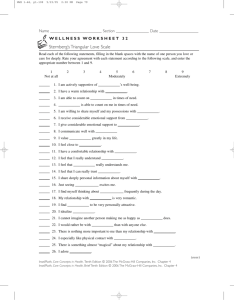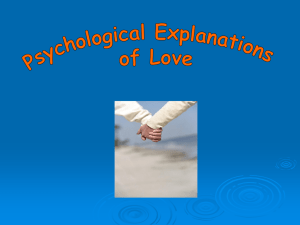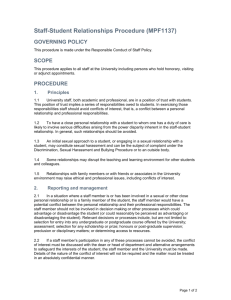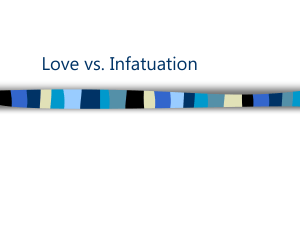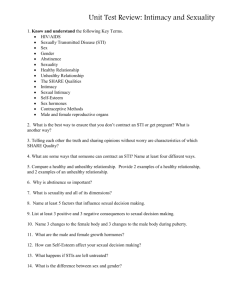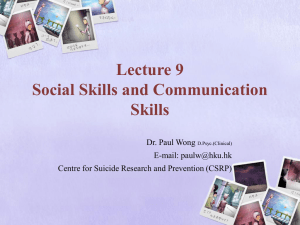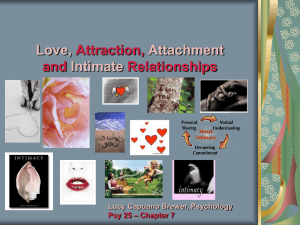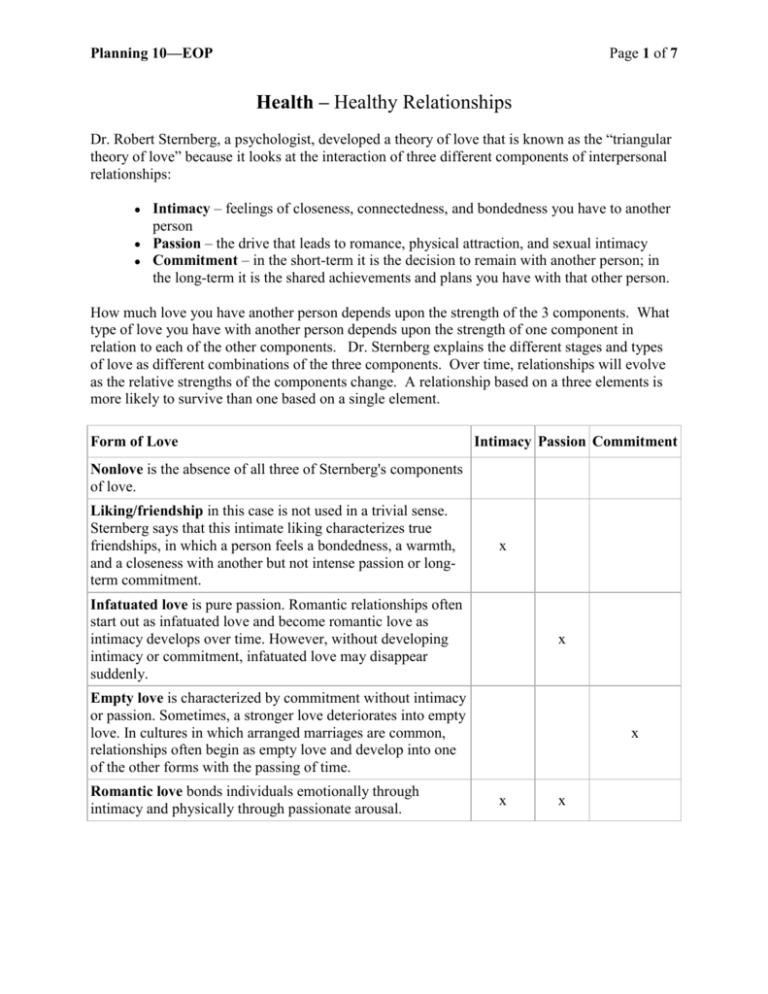
Planning 10—EOP
Page 1 of 7
Health – Healthy Relationships
Dr. Robert Sternberg, a psychologist, developed a theory of love that is known as the ―triangular
theory of love‖ because it looks at the interaction of three different components of interpersonal
relationships:
Intimacy – feelings of closeness, connectedness, and bondedness you have to another
person
Passion – the drive that leads to romance, physical attraction, and sexual intimacy
Commitment – in the short-term it is the decision to remain with another person; in
the long-term it is the shared achievements and plans you have with that other person.
How much love you have another person depends upon the strength of the 3 components. What
type of love you have with another person depends upon the strength of one component in
relation to each of the other components. Dr. Sternberg explains the different stages and types
of love as different combinations of the three components. Over time, relationships will evolve
as the relative strengths of the components change. A relationship based on a three elements is
more likely to survive than one based on a single element.
Form of Love
Intimacy Passion Commitment
Nonlove is the absence of all three of Sternberg's components
of love.
Liking/friendship in this case is not used in a trivial sense.
Sternberg says that this intimate liking characterizes true
friendships, in which a person feels a bondedness, a warmth,
and a closeness with another but not intense passion or longterm commitment.
x
Infatuated love is pure passion. Romantic relationships often
start out as infatuated love and become romantic love as
intimacy develops over time. However, without developing
intimacy or commitment, infatuated love may disappear
suddenly.
x
Empty love is characterized by commitment without intimacy
or passion. Sometimes, a stronger love deteriorates into empty
love. In cultures in which arranged marriages are common,
relationships often begin as empty love and develop into one
of the other forms with the passing of time.
Romantic love bonds individuals emotionally through
intimacy and physically through passionate arousal.
x
x
x
Planning 10—EOP
Form of Love
Companionate love is an intimate, non-passionate type of
love that is stronger than friendship because of the element of
long-term commitment. Sexual desire is not an element of
companionate love. This type of love is often found in
marriages in which the passion has gone out of the
relationship, but a deep affection and commitment remain.
The love ideally shared between family members is a form of
companionate love, as is the love between close friends who
have a platonic but strong friendship.
Page 2 of 7
Intimacy Passion Commitment
x
Fatuous love can be exemplified by a whirlwind courtship
and marriage in which a commitment is motivated largely by
passion without the stabilizing influence of intimacy. A
relationship, however, whereby an individual party agrees to
sexual favors purely out of commitment issues, or is
pressured/forced into sexual acts does not comprise Fatuous
love, and instead tends more to Empty love.
Consummate love is the complete form of love, representing
an ideal relationship toward which people strive. Of the seven
varieties of love, consummate love is theorized to be that love
associated with the ―perfect couple‖. According to Sternberg,
such couples will continue to have great sex fifteen years or
more into the relationship, they can not imagine themselves
happy over the long-term with anyone else, they overcome
their few difficulties gracefully, and each delight in the
relationship with one other. However, Sternberg cautions that
maintaining a consummate love may be even harder than
achieving it. He stresses the importance of translating the
components of love into action. "Without expression," he
warns, "even the greatest of loves can die". Thus,
consummate love may not be permanent. If passion is lost
over time, it may change into companionate love.
x
x
x
x
x
x
Planning 10—EOP
Page 3 of 7
1. Read the descriptions of the relationships below and decide what type of love is represented
in each relationship.
Description
Carl and Jessica can’t keep their eyes or
hands off each other. Carl always
walks Jessica to class and they give
each other a kiss before Carl heads to
his class. They have known each other
for 2 weeks.
Lee and Wendy have known each other
since Kindergarten. They love
spending their spare time together as
they share a lot of the same interests.
Everyone thinks they should go to the
prom together, but they don’t think of
themselves as a couple.
Anne and Kelvin met a year ago. They
are both avid video gaming fans.
Jerome and Barb have been married for
5 years. Jerome is physically and
sexually abusive to Barb. Barb feels
like she can’t leave Jerome because she
promised him ―for better or worse‖.
When he’s not being abusive Jerome
tends to hang with his friends and Barb
has her own separate interests.
Janet and Daniel have known each
other for 2 months. They declared it
was ―love at first sight‖ and have gotten
married.
Georgina and Will have been married
for 30 years. Will has Alzheimer’s
disease and Georgina cares for him.
They are no longer sexually intimate.
Georgina is committed to caring for
Will for as long as necessary, as she
knows he would do it for her. Will is
aware of who Georgina is and they
spend time together gardening etc.
Intimacy Passion Commitment
Form of Love
Planning 10—EOP
Page 4 of 7
So now you know there are different types of love, it is time to make sure you know what makes
a relationship healthy. It is so easy to get caught up in a negative relationship, so the more you
know how to recognize the warning signs the better off you will be.
2. Go to www.youngwomenshealth.org/Quizzes/quiz_healthy1.html and take the relationship
quiz. After you’ve completed the quiz, click on ―Go to the Guide‖ and read the web page
Healthy Relationships – A Guide for Teens. Identify at least 3 things you thought were
interesting or that you learned through this website.
3. Go to www.youngmenshealthsite.org/safety_in_relat.html or
www.youngwomenshealth.org/safety_in_relat.html and read the web page Safety in
Relationships – A Guide for Teens. Identify at least 3 things you thought were interesting or
that you learned through this website.
4. Make a list of 10 characteristics you look for in a friend or romantic partner.
5. What are some ―warning signs‖ that a relationship may be deteriorating?
6. What do you do to help control your own anger?
7. What do you do to help maintain healthy relationships with your friends and family?
Conflict is a normal part of life. We are all very different people...that’s what makes life
interesting. However, it is also what can make it difficult to get along with other people.
Minor conflicts can often be handled by making your concern and point of view clear. How you
express yourself can have a significant impact on whether the conflict grows or is resolve. If you
express that point of view passively, you will probably be ignored. If you express your view
aggressively, you may be viewed as being bossy or a jerk. This can often make the conflict grow
and suddenly you’ve ―made a mountain out of molehill.‖ Instead, try expressing your concerns
assertively: make a single, specific, concrete request for action, which does not make a comment
about the person.
For example, let’s say that your older brother has borrowed a video game. The passive response
would be to whine about him having it. The aggressive response would be to call him a jerk,
grab it back, or order him to give it to you right now, or else. The assertive response would be to
let him know that you let him borrow it for a specific time period and that you now want it back.
Then request that he put it on your desk in your room by a certain time of the day.
8. Imagine you have been standing in line for something you really want for 10 minutes. There
are 2 people still ahead of you. Suddenly someone comes up from behind and budges into
line between the 2 people ahead of you.
Give a passive response.
Give an aggressive response.
Give an assertive response.
Planning 10—EOP
Page 5 of 7
9. John has snuck out of the house to go to a party. His mom discovered he wasn’t at home at
about 10 p.m. John has just tried to sneak back in to the house at 1 a.m. His mom is
furious.
Give his mom’s passive response.
Give his mom’s aggressive response.
Give his mom’s assertive response.
How you handle major conflict makes all the difference between whether the conflict is resolved
and you can both move on, or whether the conflict festers and grows into something very ugly
and potentially dangerous.
When people suggest strategies for resolving conflict they tend to include a lot of ineffective
strategies:
Just walk away – this rarely works to resolve a real conflict – something you think is
important to disagree over. However, this may be a very important first step if the
conflict is highly emotional and potentially violent. Then you need to give each other
time to calm down, so later you will be able to discuss the problem rationally.
Doing nothing or ignoring it – this rarely works and generally makes the situation worse
as people begin to feel stressed and uncomfortable in each other’s presence. It can lead
to resentment.
Giving in to the other person – this rarely works when you feel the issue is important.
Eventually you will feel your needs or concerns are being overlooked or invalidated. You
will begin to feel angry and manipulated and the conflict will have grown.
Fighting dirty: lying, manipulating, threatening, or blaming – while it may be tempting
to ―get back‖ at the person, instead of resolving the conflict, it will tend to make it grow
as others are brought in to the conflict.
An effective conflict resolution strategy is to use constructive problem solving. This strategy
requires both people in the conflict to be willing to work on resolving it together. If necessary,
you could ask a third person to act as a mediator. It is important that the mediator’s job is to help
the people really listen to each other. It is not to take sides. Constructive problem solving
generally requires both people to give up a little in order to achieve a resolution. The steps
involved in constructive problem solving are
recognize there is problem,
define the problem,
brainstorm solutions,
explore alternate solutions, and
make a decision and act on it.
Planning 10—EOP
Page 6 of 7
10. Watch the humorous video and identify the 5 stages of constructive problem solving that
were used.
The previous examples tended to involve situations where the people involved would want to
resolve the conflict. There are some times, especially in school situations, but also found in the
community and in the work world, where one person really doesn’t want to resolve the conflict.
This is the case with bullies; they get some sort of ―enjoyment‖ out of prolonging the conflict. In
that case, you often need to seek the help of others—usually an adult.
Bullying is the combined use of aggression and power to harass and/or intimidate another
person. Bullying can range from exclusion, gossip, and name calling to stalking, fighting, and
theft. Bullying usually involves a power imbalance and intent to harm. The actions cause
distress and are repeated over time.
Bullies often have no logical reason for bullying other people. They often use things the person
has no control over as the focus of the bullying: race, physical size, sexual orientation, or
disability. Bullies bully to gain power. Often the bullied person feels helpless in the situation.
At that time bystanders can take action to help the victim.
Read about the Use Another Word campaign the students at a Eugene, Oregon high school used
to combat the use of disrespectful language in their school.
11. Write a paragraph on the Use Another Word campaign. Explain what it is, why it got started
and how well it worked. Do you think such a campaign would work in your school or
community organization? Would you be willing to be a part of such a campaign? At what
level would you be willing to be involved?
Harassment is any behaviour or comment that is hurtful, degrading, humiliating or offensive to
another person. Sexual harassment is a type of harassment that has sexual undercurrents. This
includes spreading sexual rumours; wearing obscene T-shirts; inappropriate touching, jokes,
comments, and postings on the Internet. Sexual harassment, like other forms of bullying, needs
to be reported.
If you are being sexually harassed, you need to tell an adult that you trust. Sexual harassment
often goes unreported because it usually involves a power difference.
What about flirting? Is it sexual harassment? The line is not always easy to see. But the real
difference is that sexual harassment is unwanted and demeaning, while flirting is wanted by both
people involved. It is possible that what starts out as flirting turns into sexual harassment. Once
what is happening is no longer comfortable, it is important to let the other person know it is
unwanted.
Planning 10—EOP
Page 7 of 7
Cyberbullying is simply bullying which is occurring on-line through the use of technology. It is
often more damaging, because of the large audience potential, as regular face-to-face bullying.
Read Cyberbullying-Rights and Responsibilities and Cyberbullying and the Law Fact Sheet.
12. For each scenario in the Cyberbullying Scenarios Handout determine the level of seriousness
from 1-5 and explaining your ranking.
13. Complete the Cyberbullying Case Study by answering the General Questions and the Group
Questions at the bottom. For the group questions, you need to put yourself in the place of
each of the people identified.

